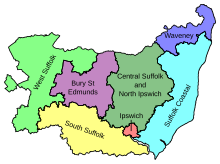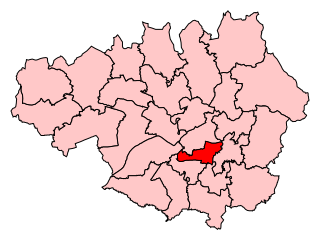Boundary reviews
| Prior to 1832 | Since 1290, the parliamentary county of Suffolk, along with all other English counties regardless of size or population, had elected two MPs (knights of the shire) to the House of Commons. The county also included seven parliamentary boroughs, namely Aldeburgh, Bury St Edmunds, Dunwich, Eye, Ipswich, Orford and Sudbury, all returning two MPs (burgesses) each. | |
|---|---|---|
| 1832 | The Reform Act 1832 radically changed the representation of the House of Commons, with the county being divided into the Eastern and Western Divisions, both returning two MPs. The boroughs of Aldeburgh, Dunwich and Orford were abolished and Eye's representation was reduced to one MP. | |
| 1844 | The Borough of Sudbury was disenfranchised for corruption and absorbed into the Western Division. | |
| 1885 | Under the Redistribution of Seats Act 1885, [1] the two 2-member county divisions were replaced by five single-member constituencies, namely the Northern or Lowestoft Division, the North-Eastern or Eye Division (which absorbed the abolished parliamentary borough of Eye), the North-Western or Stowmarket Division, the South-Eastern or Woodbridge Division and the South or Sudbury Division. The representation of the Borough of Bury St Edmunds was reduced to one MP and Ipswich continued to elect two MPs. Part of the parliamentary borough of Great Yarmouth was also in the county (see Norfolk). |  |
| 1918 | Under the Representation of the People Act 1918, [2] the parliamentary borough of Bury St Edmunds was abolished and reconstituted as a county seat, absorbing the abolished Stowmarket Division, with the exception of a small area in the south-east, including Stowmarket itself, which was transferred to Eye. The southernmost part of Lowestoft, including Halesworth, was also transferred to Eye. The representation of the Borough of Ipswich was reduced to one MP, with boundaries expanding into Woodbridge to align with those of the County Borough of Ipswich. |  |
| 1950 | The Representation of the People Act 1948 [3] resulted in the abolition of the Sudbury and Woodbridge Divisions. They were replaced by the new constituency of Sudbury and Woodbridge, incorporating the towns of Sudbury and Hadleigh from Sudbury, and Woodbridge and Felixstowe from Woodbridge. Western and northern parts of Sudbury, including Haverhill, were transferred to Bury St Edmunds and northern parts of Woodbridge were transferred to Eye. Halesworth was returned from Eye to Lowestoft. There were no changes under the First or Second Periodic Reviews of Westminster Constituencies. |  |
| 1983 | The Third Review, [4] which reflected the changes to local authorities arising from the Local Government Act 1972, did not come into effect until the 1983 general election, when Suffolk's representation was increased back up to six MPs. This resulted in major changes to the configuration of the county's seats as follows:
|  |
| 1997 | The Fourth Review [5] resulted in further major changes with the addition of a seventh constituency, named West Suffolk. This was formed from the majority of the existing Bury St Edmunds constituency, including Newmarket and Mildenhall. It also included Haverhill and surrounding areas, transferred from South Suffolk. Bury St Edmunds was reconfigured, taking western parts of Central Suffolk, including Stowmarket. Central Suffolk (renamed Central Suffolk and North Ipswich), in turn, gained westernmost parts of Suffolk Coastal, which then gained southernmost parts of Waveney, including Halesworth and Southwold. |  |
| 2010 | In the Fifth Review [6] the Boundary Commission for England recommended that Suffolk retain its current constituencies, with changes only to reflect revisions to local authority ward boundaries. The largest of these changes resulted in the effective transfer of one Borough of Ipswich ward from Central Suffolk and North Ipswich to the constituency of Ipswich. |  |
| 2024 | For the 2023 Periodic Review of Westminster constituencies, which redrew the constituency map ahead of the 2024 United Kingdom general election, the Boundary Commission for England opted to combine Suffolk with Norfolk as a sub-region of the East of England region, with the creation of the cross-county boundary constituency of Waveney Valley, which incorporated the following areas of Suffolk:
Other relatively small changes to align to ward boundaries and bring electorate numbers within the permitted electoral range. Ipswich was unchanged. [7] |  |










